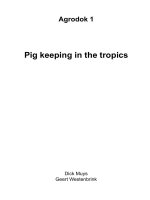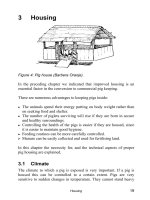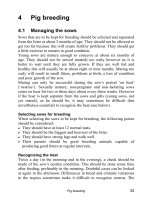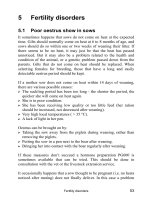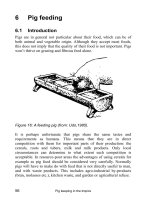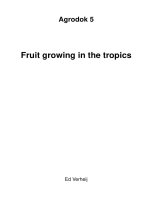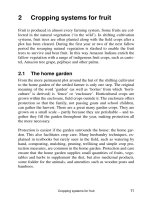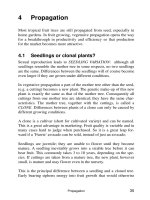Pig keeping in the tropics - part 1 docx
Bạn đang xem bản rút gọn của tài liệu. Xem và tải ngay bản đầy đủ của tài liệu tại đây (209.32 KB, 18 trang )
Agrodok 1
Pig keeping in the tropics
Dick Muys
Geert Westenbrink
© Agromisa Foundation, Wageningen, 2004.
A
ll rights reserved. No part of this book may be reproduced in any form, by print, photocopy,
microfilm or any other means, without written permission from the publisher.
First edition in English: 1984
Third (revised) edition: 1998
Fourth edition: 2002
Fifth edition: 2004
A
uthors: Dick Muys, Geert Westenbrink
Editor: Rienke Nieuwenhuis
Illustrator: Barbera Oranje
Design: Janneke Reijnders
Translation: MrS. M. Verheij and R. Corner
Printed by: Digigrafi, Wageningen, The Netherlands
ISBN: 90-77073-53-1
NUGI: 835
Foreword 3
Foreword
This revised edition has been made possible thanks to the
contributions by Mr Arie Wingelaar and Mrs Marista da Silva of the
IPC Livestock, the International Training Centre for Animal
Husbandry in Barneveld, the Netherlands.
We also wish to thank the co-workers of Agromisa who have
contributed their time and effort to this Agrodok: Mr Arno Overgraag,
Agromisa's livestock specialist, offered important suggestions and
contributions for improvements to this edition, whilst Barbera Oranje
was responsible for the illustrations and Edwin Nuijten for the lay-out.
Rienke Nieuwenhuis, editor
Wageningen 1998
Pig keeping in the tropics 4
Contents
1 Introduction 6
2 Pig keeping systems 9
2.1 Free-range 'scavenging' pig keeping 9
2.2 Semi-intensive pig keeping 12
2.3 Small-scale intensive pig keeping 16
3 Housing 19
3.1 Climate 19
3.2 Technical requirements for good housing 22
3.3 Feeding and water troughs 26
3.4 Sizes of pens and runs 28
3.5 Housing the sow and her piglets 29
3.6 Housing fattening pigs 31
3.7 Using liquid manure and dung 31
4 Pig breeding 33
4.1 Managing the sows 33
4.2 Selecting and working the boar 36
4.3 The birth and care of the new-born piglets 38
4.4 Problems related to the birth 41
4.5 Rearing motherless piglets by hand 44
4.6 Looking after and weaning piglets 46
4.7 Record-keeping 48
5 Fertility disorders 53
5.1 Poor oestrus show in sows 53
5.2 Diseases leading to fertility disorders 54
6 Pig feeding 56
6.1 Introduction 56
6.2 Nutritional requirements 57
6.3 Sources of energy, protein, minerals and vitamins 58
Contents 5
6.4 Feeding in practice 59
6.5 Feeding pigs, from weaning onwards 60
6.6 Feeding a sow and her piglets 62
7 Diseases, prevention and control 64
7.1 Prevention by promoting natural resistance 65
7.2 Disease-causing organisms 66
7.3 The use of medicines 67
7.4 Parasitic diseases 70
7.5 Bacterial diseases 72
7.6 Viral diseases 74
7.7 Feed-related diseases 76
7.8 Sunstroke 76
Further reading 77
Useful addresses 78
Glossary 80
Pig keeping in the tropics 6
1 Introduction
Pigs and pig keeping in one form or another can be found almost
anywhere in the world. Especially of course in country areas it is
common for communities to have pigs rooting and roaming freely
around the dwellings, to be brought in one day as household needs
require. Pig keeping enterprises are also to be found in and around
towns and cities, and they play an important role in feeding urban
populations.
This Agrodok looks at three typical pig-keeping systems:
? Free-range scavenging pig keeping:
A more or less extensive system whose main purpose is to
guarantee the household emergency fall-back funds, whilst also
supplying it with a little meat from time to time, without any major
investment of time or money. This domestic scale is very typical of
small farmer mixed holdings.
? Semi-intensive pig keeping:
A system differing from the above in that the animals are housed
and more attention is paid to their health and feeding. Its aims
remain those of domestic pig keeping, but given a modest amount
of inputs, its production is higher.
? Intensive pig keeping:
Which aims at producing meat for the market efficiently and
profitably, usually with larger numbers of pigs. This type of system
requires significant inputs of time and money, with careful
calculation of the costs and the resulting benefits.
We will consider the main characteristics of each of these systems, the
purposes they serve, and the methods employed, as well as noting
their limits and the ways of improving them. There are of course any
number of systems in pig keeping. The three models we describe give
an idea of the options available and the developments possible to
Introduction 7
make the transition from extensive to intensive management, with the
points to watch out for.
This book is particularly written for those who may find themselves
advising farmers involved in pig keeping. This does not mean that
those who wish themselves to set up or make changes to an existing
system will not profit from the information provided.
Anyone who is considering keeping pigs, or improving an existing
system, must before anything else be clear about the situation on the
ground, the resources available and the constraints, in order to decide
on the type of system to introduce in practice.
Advisors will first try to identify the resources available to improve a
system’s productivity, working initially on the basis of a small number
of animals and the means of production available locally. If this is
successful, and there is sufficient demand, the system can be
developed further. It must nevertheless be borne in mind that
genuinely intensive pig farming requires major investment, and that
there are great risks if such investment is not backed up with the
necessary experience and technical knowledge.
It is therefore all the more important for farmers inexperienced but
interested in this domain to establish their base progressively. They
would be best advised starting up with a semi-intensive approach,
concentrating above all on establishing good housing and proper
feeding routines for a small group of healthy animals, taking proper
advantage of all locally available resources.
Agrodok summary
The three systems of pig keeping are presented in Chapter 2, with the
various possibilities for improvement.
Chapter 3 looks at housing: why is this such an important element in
the system, and what makes for good pig housing? It outlines the
various parts of a piggery and deals with the installations required for
feeding and farrowing. It also considers the housing requirements of
the sow and her piglets, and of the fatteners.
Pig keeping in the tropics 8
Chapter 4 turns to the question of animal management, covering the
management of the mother sows and the boar(s), the birth of the
piglets and potential problems, the care of the piglets (including teeth-
trimming and castration), and finally the important question of
management records.
Chapter 5 takes a brief look at oestrus show and fertility disorders,
whilst feeding is the main preoccupation of Chapter 6 - nutritional
requirements, how to meet them, practical aspects or feeding and the
feeding of sows nursing a litter.
Finally Chapter 7 concerns the main diseases that may unfortunately
be encountered. Preventive measures are detailed, and a number of
general remarks on the use of medicines are made. The symptoms of
the diseases are described and indications are given of the treatment
possible.
Pig keeping systems 9
2 Pig keeping systems
2.1 Free-range 'scavenging' pig keeping
Figure 1: Free-range pig keeping (after Holnes, 1991).
Main characteristics
The main characteristic of this system is that the pigs move freely
around the house and surroundings, scavenging and finding for
themselves a large part of their food. Often the food they collect is
supplemented with kitchen refuse or agricultural waste products.
Few or no arrangements are made to provide the pigs with shelter, and
no money is invested in quality food or medical services.
Local breeds are commonly used, since they are more tolerant of low-
quality feed and have a higher resistance to diseases. In general there
is no attempt to improve production by selective breeding or any other
means.
In some cases the pigs are not bred on the farm: piglets are brought in
and are fattened during a season when food is plentiful, for sale at a
later date.
Production goals
In most cases the pigs are not kept to provide meat for the household,
nor as a regular source of cash income (if there is any cash income this
comes from other activities). The importance of scavenging pigs is
Pig keeping in the tropics 10
rather as a ‘savings account’ or ‘insurance policy’ i.e. they are only
sold when extra cash is needed (e.g. for buying seeds or fertiliser, at
times of illness or family festivity, to pay school fees, to make up for a
lost harvest etc.). In this way loans (with the associated problems of
high interest rates and repayment) can be avoided.
Pigs can also play a specific role in social life, when at weddings and
other festivities they are presented as gifts or offered as food.
Socio-economic aspects
Traditionally pigs are often owned or kept by women (and/or
children), with the result that any financial benefits usually go towards
the needs of the household. It also has the effect of strengthening the
women’s economic position.
Keeping scavenging pigs requires a minimum amount of inputs. The
financial risks involved in this system are small, with little money
being invested and little time spent looking after the pigs.
Potential for improvement
The main constraints with scavenging pigs are the high rates of piglet
loss, and slow growth rates. Pigs kept in a free-range system will not
grow quickly, because they expend a lot of energy in their scavenging
activities. Worm infestation is also an important problem resulting in
slower growth rates.
? Enclosing the pigs
Enclosing your animals can lead to improved management. Keeping
pigs together by fencing a piece of land may be difficult to
introduce, but it is the first thing to do if you are aiming to bring
piglet death rates down, reduce the energy lost in scavenging, and
improve the health and growth rates of your pigs. To make a fence,
strong wire netting is ideal, but you can also use local materials
such as bamboo, thorny shrubs, tree trunks etc. The fence must be
sufficiently dense that even the small piglets cannot escape.
Shade is essential. If there are no trees or other source of shade a
small shelter must be provided (Figure 1). The animals can also
Pig keeping systems 11
shelter there when it rains heavily. The structure can be as simple as
four solid tree trunks with a roof on top.
Further improvements can be made by separating the animals into
different groups according to their final purpose. Animals for
fattening and not for breeding should be kept enclosed. For these
animals rapid growth is important. By caring for them well, in a
small clean pen if possible, higher growth rates are possible than for
animals left to roam outside. Most of the breeding stock however
can be left outside. The pregnant sows should be separated from the
others just before farrowing and brought inside to deliver. With
proper housing a greater number of piglets will thrive.
? Feeding the pigs
Providing scavenging pigs with extra feed will improve their
growth. Root crops and almost any village refuse can be fed . If the
pigs are enclosed, part of the land can be used for growing green
fodder. At the same time there must always be an adequate supply
of fresh drinking water available for them.
? Prevention of worms
Parasites pose a serious problem when keeping pigs outside, as the
wet tropics provide ideal conditions for them. Worms are the most
common parasites. A pig infected with worms will be in poor health
and will grow very slowly. If the pigs are kept in an enclosure,
measures must be taken to control the levels of worm infestation.
This is explained in the next section (2.2).
Pig keeping in the tropics 12
2.2 Semi-intensive pig keeping
Figure 2: Semi-intensive pig keeping (after Holnes, 1991).
Main characteristics
In semi-intensive systems pigs are confined to a limited space. This
means that that they cannot gather their own food and are completely
dependent upon their keeper. Once or twice a day fresh water and
fodder (usually kitchen refuse or agricultural waste) have to be
brought to the pigs. This system of pig keeping opens up possibilities
for improved feed and disease control, which in turn can result in
faster growing and healthier pigs and/or in larger litters.
Apart from the economic reasons there are also some very practical
reasons for keeping the animals tethered or enclosed. It prevents crops
from being damaged by the pigs for example, and it reduces the risk of
the pigs being stolen.
Although this system of pig keeping demands only low financial
inputs, more time and effort needs to be spent on the pigs. More
technical knowledge is also required.
Production goals
In general the creation of a ‘savings account’ or ‘insurance policy’
remains the most important strategy underlying this form of pig
Pig keeping systems 13
keeping. Nevertheless in areas close to urban centres or on main
traffic routes for example, where it is possible to sell pigs more
regularly, small-holders (often women) will have intensified their pig
keeping by adopting the semi-intensive approach.
Socio-economic aspects
The introduction of a commercial approach may have an impact on the
balance of income earned within a family. The result is often to the
detriment of the women and children. For if, traditionally, women
were involved in pig keeping, it is often the men who get involved
when the pigs become commercially interesting. This comes about
because the extension services are often reluctant to work with
women, and because the women themselves are often obliged to make
applications to or through their menfolk for access to credit or land, or
for help with construction work or farm-related book-keeping. This
process leaves women less able to decide for themselves what will be
done with the animals and the cash income earned; this reduces their
independence.
Potential for improvement
Improvements to semi-intensive systems are made by focusing
attention on feeding and health care practices, and by selective
breeding.
? Feeding
A first and simple step can be taken by making sure that the
available feedstuff is properly distributed. It is important that the
best of the feedstuff be given to the pregnant and the nursing sows
(who supply your future breeding stock), and also to the piglets that
have just been weaned so that they get off to a good start in life.
A further improvement to be made is to raise the quality of the feed
by adding to the basic ration. For this see Chapter 6, which deals
with feeding issues. If additional feed has to be bought in, you
should first consider whether the advantages really justify the cost.
This will depend on several factors, such as the quality of your meat
Pig keeping in the tropics 14
and the price you finally obtain for it, and the total cost of bringing
in and storing the feed.
? Breeding
A farmer can improve the quality of new stock by choosing the
right animals to breed from (selective breeding). If nursing sows
and their piglets are kept separate from the others, it will be easier
to select the stronger piglets for breeding. The remaining piglets can
be fattened for sale or for slaughter.
Once you have started separating out the best sows for breeding
(see Paragraph 4.1), giving them good housing and proper attention,
you have taken the essential steps towards improved breeding
practice. And once this is achieved it could be worthwhile investing
in a good boar to produce strong healthy litters. Buying a boar is a
serious investment, as it involves a number of costs - travelling in
search of a good animal, transport costs, purchase price The costs
can only be recovered if conditions on the farm allow.
The purchase of a boar is a project that a group of farmers may wish
to undertake together. It is also very useful to exchange boars
between neighbouring villages, in order to avoid the problems of in-
breeding.
This level of management however demands more knowledge,
experience and time, in the keeping of records for example or
routine checks for heat etc. See Chapter 4 for more information on
improving breeding.
? Prevention of worms
We mentioned above the problem of worm infestation in outdoor
pigs. In fact the adult worms live and develop inside the pig, laying
eggs which are excreted with the faeces onto the soil. Given the
right temperature and humidity, larvae emerge from the eggs and
will probably be eaten again by the grazing pig. These larvae can
even penetrate into and cross the animal’s skin. Once inside the pig,
they grow into mature worms again and the cycle can start again.
Pig keeping systems 15
The eggs and the larvae in the soil can die out after a while if
sufficient time passes for them to dry out under the sun. As a result
of this the risk of serious parasite build-up in the field can be
reduced by regularly changing the grazing area. If possible the
animals should be given a fresh piece of ground about every 14
days. In dry periods the animals can stay longer in the same field
because the worms do not develop so quickly.
After a period of grazing the field should be left empty for a while
to allow the larvae to die. In the wet season it is better to leave a
field for about 2.5 to 3 months before re-using it; in the dry season
when the larvae and eggs die more quickly, the field can be used
again after 2 months. With this system, changing the enclosure
every two weeks requires at least four different fields, which is
expensive. If there is a shortage of land, in some areas a simple
pigsty can be made to keep the pigs in during the wet season. By
letting the pigs out in the dry season only, less land will be required.
Animals kept outside will always be slightly contaminated with
worms. Some infestation in older animals is not serious, as these
animals usually have some natural resistance. Young piglets
however are very vulnerable. To prevent young piglets from being
infected directly after birth, the breeding sows should be wormed
about 1 week before delivery (treatment which drives out all the
worms). After worming, the sows should be washed to ensure that
there are no worm eggs clinging to them. They should then be kept
inside for delivery.
To prevent re-contamination, the pen should be properly cleaned
every day. All this being done, the young piglets stand a good
chance of being born into a worm-free environment. See Paragraph
7.4 for more information on this.
? Use of pig manure
It is a good idea to use the pig fields occasionally for crops, as the
soil will have been fertilised by the pig manure. This will also clean
out the parasites and after a year’s cropping the soil should be
completely clear again.
Pig keeping in the tropics 16
2.3 Small-scale intensive pig keeping
Figure 3: Small-scale intensive pig keeping (after Holnes, 1991).
Main characteristics
The main characteristics of an intensive pig keeping system is that
pigs are kept in complete confinement. Buildings are provided to keep
fatteners, boars, sows, and sows with their litters separate. In this
system housing amounts to much more than providing a simple
shelter. Larger numbers of pigs may be kept and the pigs must be well
managed because commercial commitments have been made. Know-
how is required to make the right decisions at the right time. The
following chapters in this book provide a lot of this know-how,
because they concentrate on the management of small-scale intensive
pig keeping.
High investments are required to provide improved buildings, and to
buy in feeds and medicines. These are especially necessary if the
change towards improved breeds is made.
In this system of pig keeping, kitchen refuse and agricultural waste
products will generally not be sufficient to feed the animals, so certain
feeds will have to be bought. Buying in extra feed to help the pig grow
faster only makes sense if the animal can be marketed earlier than
Pig keeping systems 17
usual or if heavier animals can be sold, thus earning much higher
prices.
Local breeds are often considered to be a cause of low productivity
(small litter sizes and slow growth rates). In general, however, these
breeds are very well adapted to the local circumstances. Although
‘improved’ breeds have great potential they make high demands on
feed quality and careful husbandry.
Intensive systems are aimed to provide a major source of income for a
group or household. The animals no longer function as a savings
account but are grown to be marketed. This means that regular access
to the market is needed, which might imply dependence on a
middleman.
Potential for improvement
The improvement of small-scale intensive systems needs specialised
know-how. Progress can be achieved particularly by paying attention
to the animals’ health and conditions. The stability of the project
depends on a new approach to production, as the farmer has to be
thinking more and more in terms of the market.
? Marketing
To render the unit economically viable a completely different
approach to keeping pigs is necessary. The animals have to be
brought to market when conditions (prices, the pigs’ condition etc.)
are right. A strategy for optimum buying and selling has to be
developed, taking into account the importance of regular transport
and dependable sales outlets.
If there are problems or a catastrophe with the pigs (disease or
accident for example), an extra financial input will have to be
available to keep the unit in operation. This is not typical in
traditional pig keeping.
? Technical knowledge
A local extension service is important as a source of support and
technical advice. Veterinary services should also be available when
required.
Pig keeping in the tropics 18
To be able to manage the business correctly proper detailed records
must be kept (see Paragraph 4.7).
? Disease control
If too many pigs are confined together there is a high risk of
infection spreading quickly among the animals. For most diseases
and infections the organisms causing the disease (bacteria, worms
etc.) are found naturally in the animal’s environment. A lot of
locally bred pigs are infected but have enough natural resistance to
stay alive and even to develop. This natural equilibrium can
however very easily be disturbed, with the result that the pigs
sicken or die. This can be due to changes in the season (in the wet
season, parasites are often present in larger numbers), feed
shortages (which weaken the animals) or changes in pig keeping
routines.
Preventive measures aim at increasing the animals’ resistance (for
example by improving the quality of the feed) and they aim at
reducing the sources of infection, e.g. by keeping a smaller number
of animals in the same area or by improved hygiene (providing dry
and clean housing, regularly moving the pens etc.). When large
numbers of pigs are kept together medicines are sometimes
necessary to prevent disease outbreaks. The most essential and
powerful tool to combat disease however remains good hygiene.
By ensuring that the pen is always kept clean the chances of
infection remain small, and a healthy pig will grow faster than an
animal infected with disease. See Chapter 7 for the prevention and
control of diseases.

